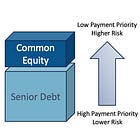Our recent case study is a CRE deal where 80% of the equity is provided by a single JV partner, with the remaining portion syndicated to retail limited partners (LPs). Such deals are not uncommon, and yet very few people understand the implications. Many LPs assume their interests align with the JV partner who contributes the majority of the capital, but this assumption is often misguided. Today I’ll explain why.
What is a JV Deal?
First things first. A joint venture (JV) deal is a partnership between two or more parties to undertake a real estate project. In most cases, one party—the institutional JV partner—provides the majority of the capital (70-90%), while the other party—the General Partner (GP)—manages the project. Increasingly, we see GPs syndicating the remaining equity to retail investors (we’ll call this “minority LP equity”).
JV equity can be structured as either common equity or preferred equity. In this discussion, we’ll focus on deals structured on a pari passu basis, meaning the JV partner’s equity and the minority LP equity are treated equally. (If you don’t know what this means, for the love of all that’s good, don’t invest).
For an explanation of preferred equity structures, see our primer on capital stacks:
We’ll explore JV equity from three perspectives: the GP’s, the JV partner’s, and the minority LP’s. You will find a list of questions every LP should ask at the end of the article.







